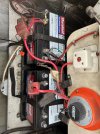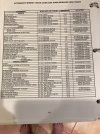I have a 1999 Advance 247 with a 225 ox66
I will start by saying I have minimal knowledge about marine batteries and wiring on a boat. ( I thought a 12v battery was fully charged at 12 not 12.7)
I bought two new batteries charged both to 12.7 volts (checked with voltmeter)
Hooked them to the boat with the battery switch off still reading 12.7/ switch on reading 12.55
The meter on the dash reads 12.4
Took the boat out dash meter reads 12.4 came up on plane dash meter reads 12.2 and stays there entire trip used the tilt/trim a couple of times meter on dash reads 12.2 drops all the way to 11.8 when I tilt while on plane
Come back in turn the battery switch off now batteries read 12.48
Is this normal or should I be looking for a problem in the system?
(I can post a picture of the batteries and how they are wired later today)
I will start by saying I have minimal knowledge about marine batteries and wiring on a boat. ( I thought a 12v battery was fully charged at 12 not 12.7)
I bought two new batteries charged both to 12.7 volts (checked with voltmeter)
Hooked them to the boat with the battery switch off still reading 12.7/ switch on reading 12.55
The meter on the dash reads 12.4
Took the boat out dash meter reads 12.4 came up on plane dash meter reads 12.2 and stays there entire trip used the tilt/trim a couple of times meter on dash reads 12.2 drops all the way to 11.8 when I tilt while on plane
Come back in turn the battery switch off now batteries read 12.48
Is this normal or should I be looking for a problem in the system?
(I can post a picture of the batteries and how they are wired later today)




